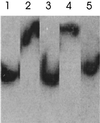Regulation of Streptococcus gordonii sspB by the sspA gene product - PubMed (original) (raw)
Regulation of Streptococcus gordonii sspB by the sspA gene product
A El-Sabaeny et al. Infect Immun. 2001 Oct.
Abstract
Streptococcus gordonii expresses two related adhesins, SspA and SspB, the genes for which are adjacent on the chromosome and are regulated independently. Although the adhesins are functionally similar, the sspA promoter is more active than that of sspB. In this study we show an additional role for SspA in the control of sspB activity. Gel shift and DNA footprinting assays demonstrate that the SspA protein binds to the sspB promoter and protects a region 233 to 264 bp upstream of the predicted -35 promoter element. The responsiveness of the sspB promoter to SspA was investigated with a promoter-cat reporter. Expression of the sspB promoter was reduced by over 60% in an SspA-deficient mutant of S. gordonii. These results indicate that expression of S. gordonii sspB is positively regulated by the sspA gene product.
Figures
FIG. 1
Electrophoretic mobility shift analysis of binding of SspA to the sspB upstream promoter-containing region. A 364-bp 32P-labeled sspB upstream fragment was used as the probe. Reaction mixtures contained probe alone (lane 1), probe with SspA protein (lane 2), probe with SspA and excess unlabeled probe (lane 3), probe with SspA protein and excess E. coli DNA (lane 4), or probe with sonicated E. coli extract containing cloned DNA binding domain from EBNA-1 (lane 5).
FIG. 2
(A) DNase I footprint of protection by SspA of a 279-bp sspB upstream region. Lane 1, Maxam and Gilbert A+G ladder; lanes 2 to 5, DNase I treatment in the presence of 0, 1, 2, and 4 μg of SspA, respectively. The 32-bp protected sequence is indicated by a bracket. (B) DNA sequence upstream of sspB. The 32-bp region protected from DNase I digestion is underlined.
FIG. 3
Growth phase and expression of sspB in an SspA+ (strain HA00) or SspA− (strain HA02) background. Optical densities (O.D.) and CAT activities were measured at different incubation times. The data are from a representative of three experiments.
Similar articles
- Inactivation of Streptococcus gordonii SspAB alters expression of multiple adhesin genes.
Zhang Y, Lei Y, Nobbs A, Khammanivong A, Herzberg MC. Zhang Y, et al. Infect Immun. 2005 Jun;73(6):3351-7. doi: 10.1128/IAI.73.6.3351-3357.2005. Infect Immun. 2005. PMID: 15908361 Free PMC article. - Environmental conditions modulate the expression of the sspA and sspB genes in Streptococcus gordonii.
El-Sabaeny A, Demuth DR, Park Y, Lamont RJ. El-Sabaeny A, et al. Microb Pathog. 2000 Aug;29(2):101-13. doi: 10.1006/mpat.2000.0369. Microb Pathog. 2000. PMID: 10906265 - Interruption of the Streptococcus gordonii M5 sspA/sspB intergenic region by an insertion sequence related to IS1167 of Streptococcus pneumoniae.
Demuth DR, Duan Y, Jenkinson HF, McNab R, Gil S, Lamont RJ. Demuth DR, et al. Microbiology (Reading). 1997 Jun;143 ( Pt 6):2047-2055. doi: 10.1099/00221287-143-6-2047. Microbiology (Reading). 1997. PMID: 9202480 - Tandem genes encode cell-surface polypeptides SspA and SspB which mediate adhesion of the oral bacterium Streptococcus gordonii to human and bacterial receptors.
Demuth DR, Duan Y, Brooks W, Holmes AR, McNab R, Jenkinson HF. Demuth DR, et al. Mol Microbiol. 1996 Apr;20(2):403-13. doi: 10.1111/j.1365-2958.1996.tb02627.x. Mol Microbiol. 1996. PMID: 8733238 - Binding properties of Streptococcus gordonii SspA and SspB (antigen I/II family) polypeptides expressed on the cell surface of Lactococcus lactis MG1363.
Holmes AR, Gilbert C, Wells JM, Jenkinson HF. Holmes AR, et al. Infect Immun. 1998 Oct;66(10):4633-9. doi: 10.1128/IAI.66.10.4633-4639.1998. Infect Immun. 1998. PMID: 9746559 Free PMC article.
Cited by
- Communication among oral bacteria.
Kolenbrander PE, Andersen RN, Blehert DS, Egland PG, Foster JS, Palmer RJ Jr. Kolenbrander PE, et al. Microbiol Mol Biol Rev. 2002 Sep;66(3):486-505, table of contents. doi: 10.1128/MMBR.66.3.486-505.2002. Microbiol Mol Biol Rev. 2002. PMID: 12209001 Free PMC article. Review. - Inactivation of Streptococcus gordonii SspAB alters expression of multiple adhesin genes.
Zhang Y, Lei Y, Nobbs A, Khammanivong A, Herzberg MC. Zhang Y, et al. Infect Immun. 2005 Jun;73(6):3351-7. doi: 10.1128/IAI.73.6.3351-3357.2005. Infect Immun. 2005. PMID: 15908361 Free PMC article. - Structural and functional variation within the alanine-rich repetitive domain of streptococcal antigen I/II.
Demuth DR, Irvine DC. Demuth DR, et al. Infect Immun. 2002 Nov;70(11):6389-98. doi: 10.1128/IAI.70.11.6389-6398.2002. Infect Immun. 2002. PMID: 12379719 Free PMC article. - Microbial interactions in building of communities.
Wright CJ, Burns LH, Jack AA, Back CR, Dutton LC, Nobbs AH, Lamont RJ, Jenkinson HF. Wright CJ, et al. Mol Oral Microbiol. 2013 Apr;28(2):83-101. doi: 10.1111/omi.12012. Epub 2012 Dec 17. Mol Oral Microbiol. 2013. PMID: 23253299 Free PMC article. Review. - Structure-Function Characterization of Streptococcus intermedius Surface Antigen Pas.
Mieher JL, Schormann N, Wu R, Patel M, Purushotham S, Wu H, Scoffield J, Deivanayagam C. Mieher JL, et al. J Bacteriol. 2021 Sep 23;203(20):e0017521. doi: 10.1128/JB.00175-21. Epub 2021 Aug 2. J Bacteriol. 2021. PMID: 34339301 Free PMC article.
References
- Demuth D R, Duan Y, Brooks W, Holmes A R, McNab R, Jenkinson H F. Tandem genes encode cell-surface polypeptides SspA and SspB which mediate adhesion of the oral bacterium Streptococcus gordonii to human and bacterial receptors. Mol Microbiol. 1996;20:403–413. - PubMed
- Demuth D R, Duan Y, Jenkinson H F, McNab R, Gil S, Lamont R J. Interruption of the Streptococcus gordonii M5 sspA/sspB intergenic region by an insertion sequence related to IS1167 of Streptococcus pneumoniae. Microbiology. 1997;143:2047–2055. - PubMed
- El-Sabaeny A, Demuth D R, Park Y, Lamont R J. Environmental conditions modulate the expression of the sspA and sspB genes in Streptococcus gordonii. Microb Pathog. 2000;29:101–113. - PubMed
- Heppel L A. Selective release of enzymes from bacteria. Science. 1967;156:1451–1455. - PubMed
Publication types
MeSH terms
Substances
Grants and funding
- T32 DE007023/DE/NIDCR NIH HHS/United States
- DE07023/DE/NIDCR NIH HHS/United States
- DE12505/DE/NIDCR NIH HHS/United States
- P60 DE013061/DE/NIDCR NIH HHS/United States
- R01 DE012505/DE/NIDCR NIH HHS/United States
- DE13061/DE/NIDCR NIH HHS/United States
LinkOut - more resources
Full Text Sources
Other Literature Sources
Miscellaneous


